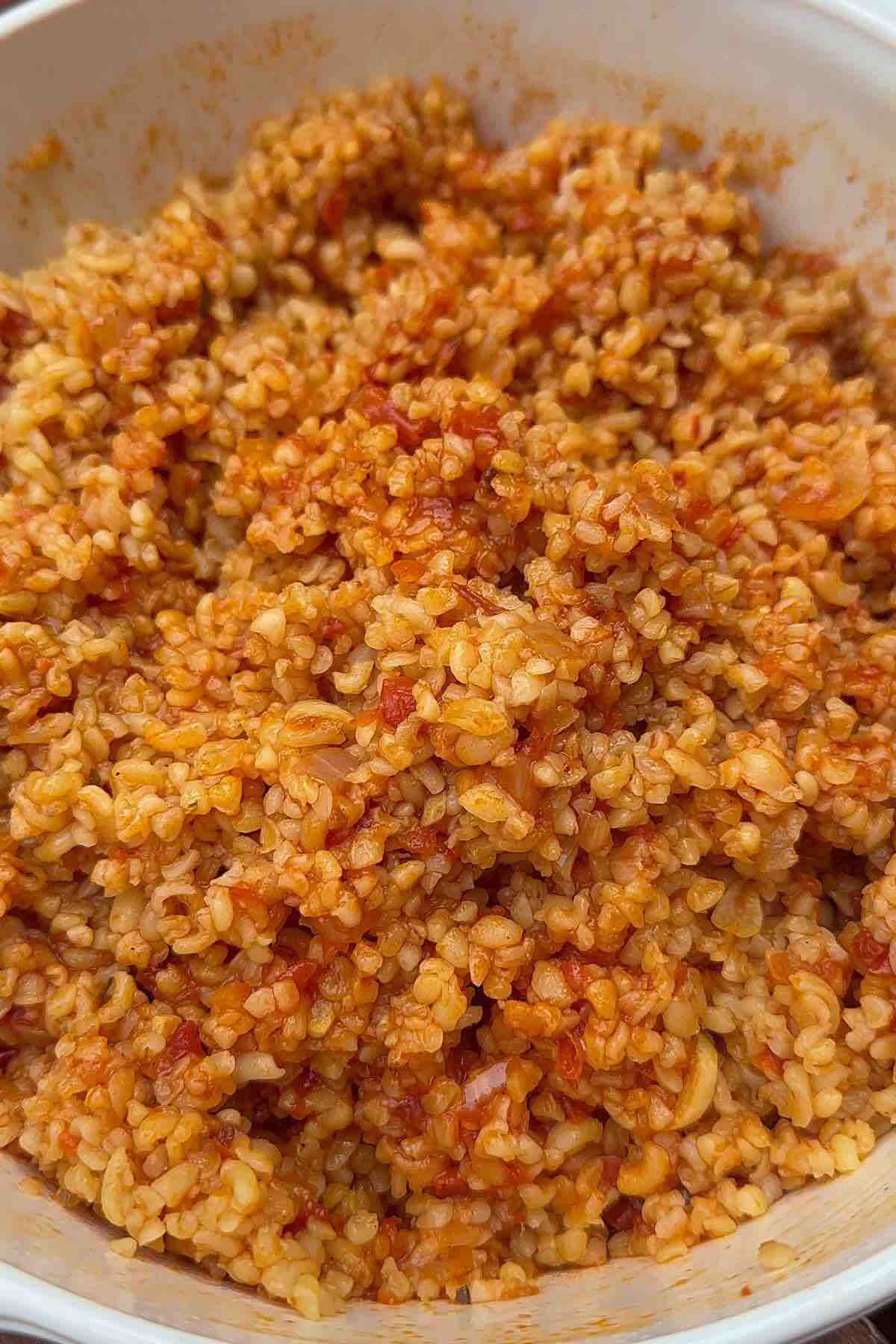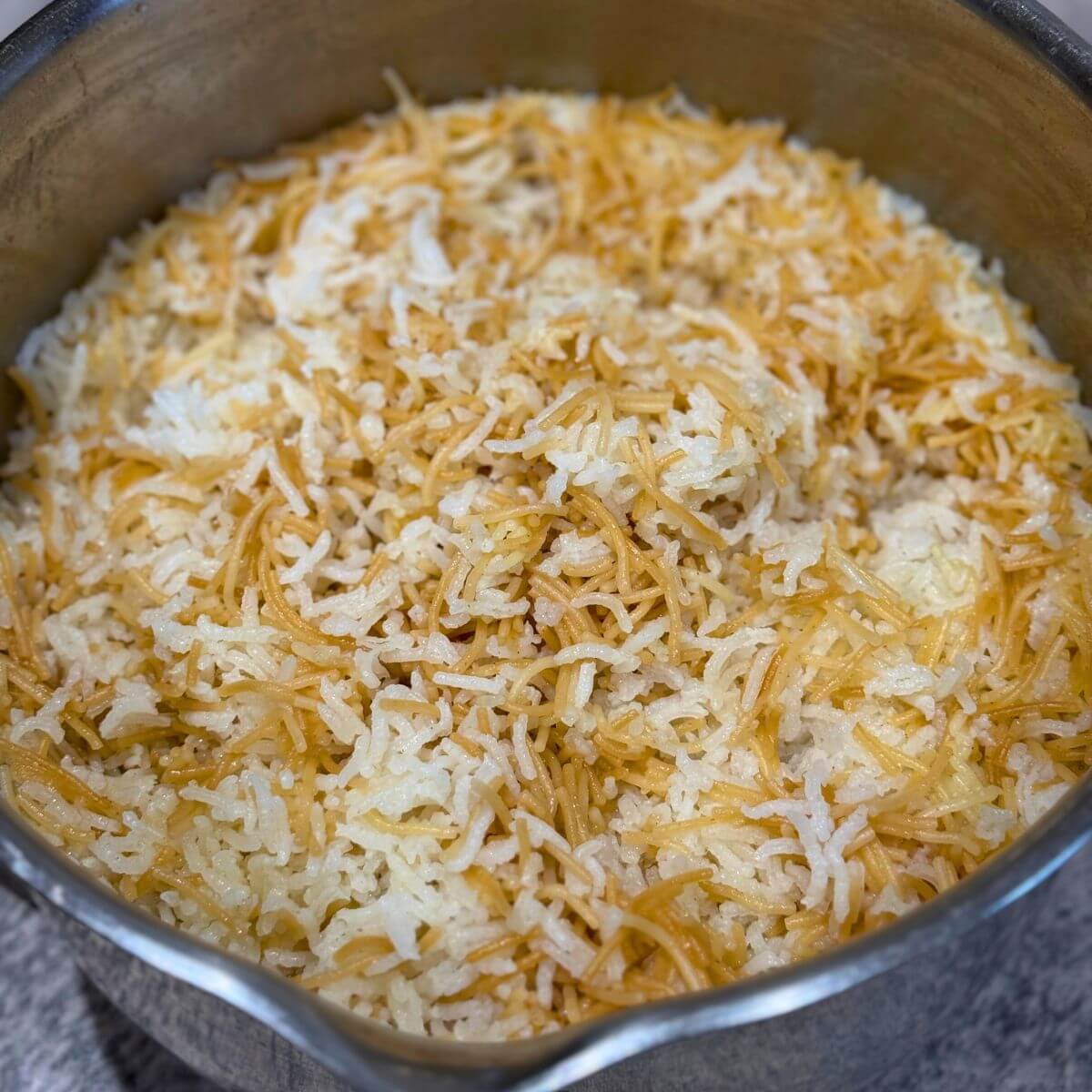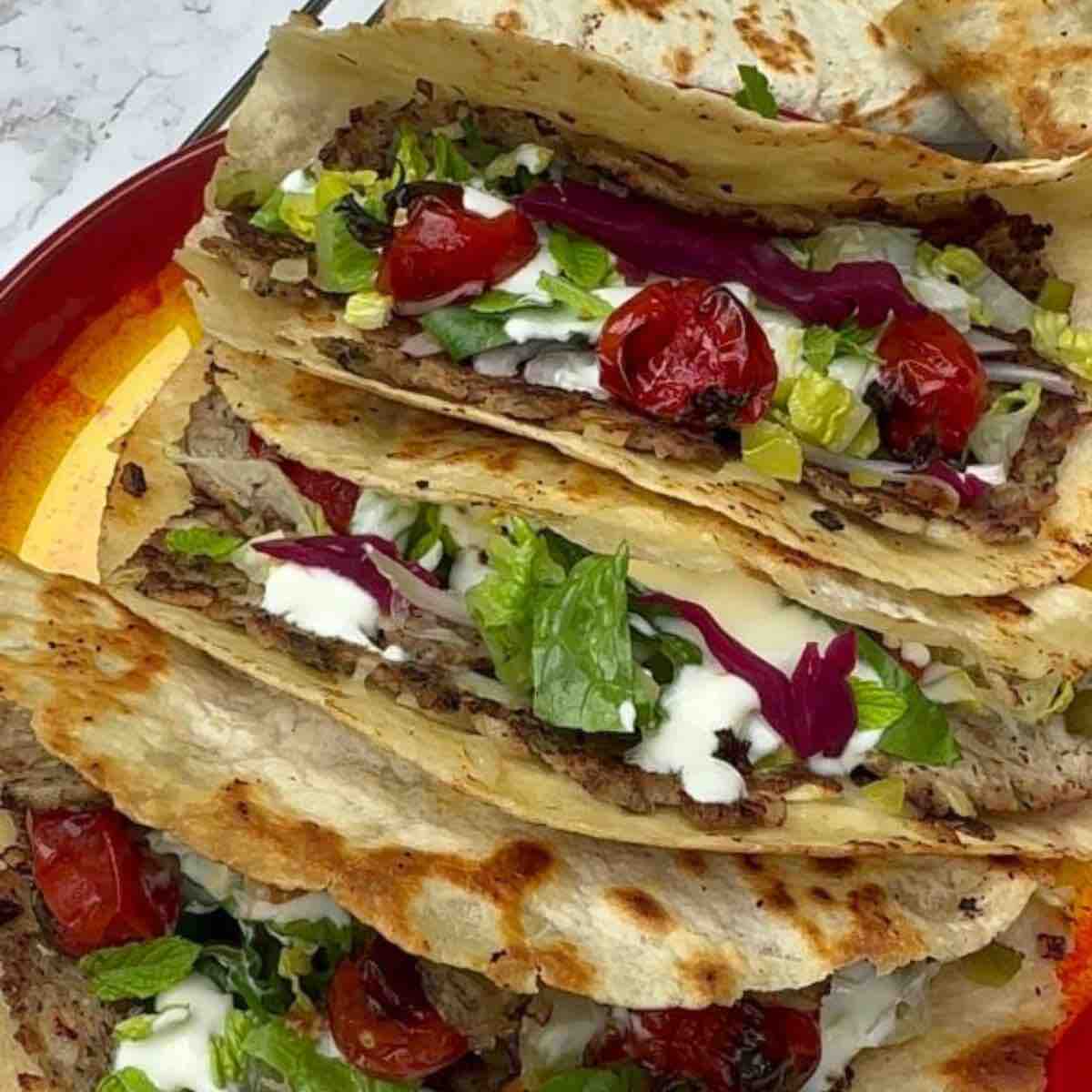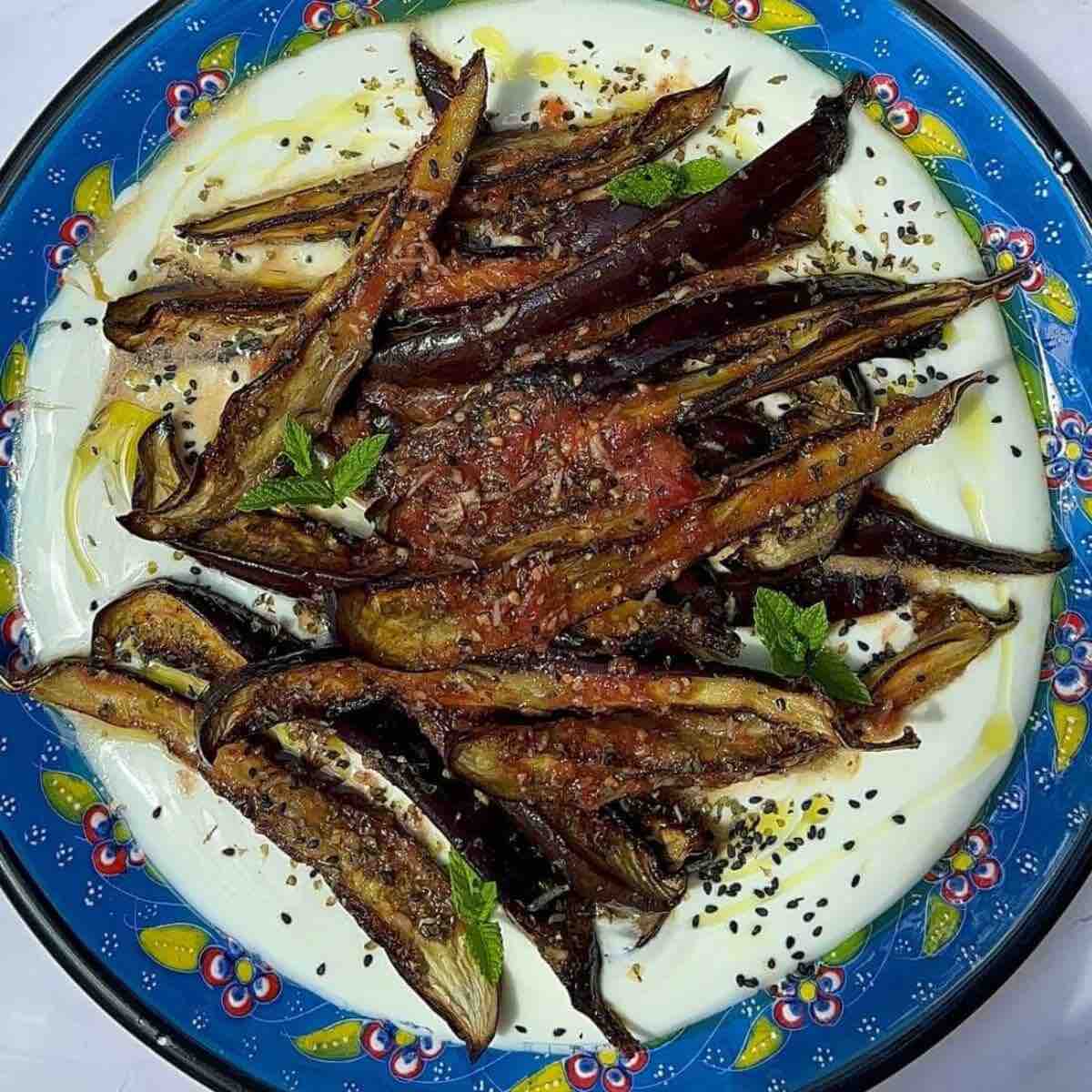This 30-minute Turkish Bulgur Pilaf is a healthy and tasty dish made with bulgur, onions, peppers, and spices. It’s quick and easy to make, perfect as a side or main meal, especially with yoghurt or a fresh salad.

I always keep this recipe handy when I need a side dish that's not the usual rice or mashed, or baked potatoes. It’s a different grain with a unique texture and taste that adds something new to the table.
Turkish cuisine is one of my favourites, and I love trying out its recipes and ingredients. I’m a big fan of dishes like börek and meatballs with Hasselback potatoes. Pide is especially awesome because it's so versatile and perfect for using up leftovers.
Jump to:
What is Bulgur?
Bulgur is a whole grain made from cracked durum wheat. It’s partially cooked, dried, and crushed into various sizes, from fine to coarse. Popular in Middle Eastern and Mediterranean cuisines, it has a nutty flavour, chewy texture, and cooks quickly. It's commonly used in pilafs, salads like tabbouleh, and other dishes, and is rich in fibre, vitamins, and minerals.
What’s the difference between fine and coarse bulgur?
- Bulgur comes in four different textures: fine, medium, coarse, and very coarse.
- Fine bulgur has the smallest grains and is perfect for dishes like tabbouleh and kibbe. It doesn't need to be cooked, just soaked.
- Medium bulgur is used in recipes like veggie burgers, porridge, or stuffing vegetables.
- Coarse bulgur has larger grains and is ideal for heartier dishes like pilafs, while very coarse bulgur is used for robust, textured dishes.
💗 Why This Recipe Works
✅ Ready in 20 minutes – Faster than takeout
✅ One-pot wonder – Minimal cleanup
✅ Naturally vegan & gluten-free – No substitutions needed
✅ Meal-prep friendly – Tastes better the next day
🥘 Ingredients

*See the recipe card for full information on ingredients and quantities.
- Coarse bulgur – I always use coarse bulgur when I make pilaf. It holds its shape well and doesn’t turn mushy like the fine one can. If you're not sure what to buy, look for packaging labelled as #3 or "coarse"—that's the one you need.
- Green pepper – I usually go for Turkish-style green peppers when I can find them—they’re mild and just a little sweet. But if you're using regular green bell pepper, that works too. It still adds nice colour and crunch.
- Grated tomatoes – I try to find ripe, juicy tomatoes like Roma or vine tomatoes when making pilaf. They have fewer seeds, more flesh, and grate easily. Grating them gives you a smooth sauce that really coats the bulgur well without needing to peel or chop. If your tomatoes aren’t very ripe, you can add a pinch of sugar to balance the acidity.
- Tomato paste – It's handy to keep a tube of it in the fridge—it lasts ages and adds so much to simple recipes.
♻️ Substitutions
If you're missing some ingredients from your pantry, it's helpful to know what can be used as a substitute. That's why I like to mention some alternatives.
- Coarse bulgur – If you only have fine bulgur, you can still make this recipe, but skip simmering it. Just pour hot water or stock over it, cover, and let it sit for about 10–15 minutes until soft. Keep in mind the texture will be softer and a bit more like a mash than a pilaf. Then combine with the tomato sauce.
- Onion: Substitute with shallots or leeks.
- Green Pepper: Use red or yellow bell pepper instead.
- Garlic Cloves: Replace with garlic powder.
- Tomatoes: Use canned diced tomatoes or tomato puree.
- Olive Oil: Replace with vegetable oil or canola oil.
📋 Variations
- Vegetable Bulgur Pilaf: Sauté onions, garlic, and your choice of vegetables such as bell peppers, carrots, peas, or zucchini. Add the bulgur and vegetable broth, then cook until the bulgur is tender. Season with herbs like parsley, thyme, or oregano.
- Mediterranean Bulgur Pilaf: Cook the bulgur with vegetable broth, then stir in chopped sun-dried tomatoes, Kalamata olives, and crumbled feta cheese. Finish with a drizzle of olive oil and a squeeze of lemon juice.
- Spiced Bulgur Pilaf: Toast the bulgur in a bit of olive oil, then add chopped onions, garlic, and your favourite spices such as cumin, coriander, paprika, or turmeric. Cook with vegetable broth until the bulgur is fluffy and aromatic.
- Mushroom Bulgur Pilaf: Sauté sliced mushrooms with onions and garlic until they release their moisture. Add the bulgur and vegetable broth, then cook until the bulgur is tender. Finish with a sprinkle of fresh parsley or thyme.
- Tomato Bulgur Pilaf: Sauté onions and garlic until softened, then add diced tomatoes and cook until they break down. Add the bulgur and vegetable broth, then cook until the bulgur is cooked through. Season with salt, pepper, and herbs like basil or oregano.

🥗 Serving Suggestions
- As a side dish, Bulgur pilaf can be served as a side dish alongside roast lamb stuffed with rosemary and garlic, grilled meats, and fish: salmon en papillote ( salmon in parchment) recipe or stews: one-pan beef stew or Korean BBQ beef bowl (easy melt-in-your-mouth Bulgogi) with chicken, creamy chicken with spinach and peppers or quick lemon chicken skillet 30 minutes.
- Salad base: Use bulgur pilaf as a base for salads. Add to Greek salad with cherry tomatoes & feta (15-minute recipe!) You can also include protein sources like grilled chicken, chickpeas, or feta cheese. Drizzle with lemon juice or a light dressing for added flavour.
- Wrap or roll: Spread a layer of bulgur pilaf on a flatbread or tortilla, and add your choice of fillings such as grilled chicken, falafel, or Şakşuka (Turkish fried vegetables). Roll it up and enjoy it as a wholesome wrap or roll.

❓FAQs
A: It depends on the type and texture you want:
- Coarse bulgur: 1½ cups water or stock per 1 cup bulgur
- Medium bulgur: 1½ cups water or stock per 1 cup bulgur
- Fine bulgur: 2 cups water or stock per 1 cup bulgur
For a fluffier texture, use a bit more water
For a softer, stickier texture, go with 2 cups of water per cup of bulgur (any type)
Coarse bulgur is your best bet. It holds up well during cooking and soaks up all the tomato and stock, giving the pilaf great texture and taste.
Yes, and it turns out great! Melt about 2 tablespoons of butter in a heavy saucepan over medium heat, then stir in the bulgur and rice. Let them toast for about 5 minutes, until the rice starts to brown slightly. After that, pour in the broth, bring it to a boil, then lower the heat, cover, and cook for about 20 minutes—just until the liquid is fully absorbed. It’s an easy way to add some extra texture and heartiness to a simple dish.
Try these easy pairings
Proteins: Rosemary lamb roast or spinach chicken
Vegetarian: Şakşuka (Turkish fried vegetables) or Sweet & Sour Vegetable Stir Fry
Meal prep: Greek feta salad bowls
Keep any leftovers in an airtight container in the fridge for up to 3 days. They’re great tossed into salads (like my Mediterranean cucumber salad), wrapped in flatbreads, or even turned into quick patties.
If You Enjoyed This Recipe, You Will Love These Too
Tried this recipe? Give it a star rating below! ⭐⭐⭐⭐⭐
HUNGRY FOR MORE? Subscribe to my newsletter and follow along on Facebook, Pinterest, and Instagram for the latest updates.










Claudia Ciorteanu says
My family loved this!
Swathi says
Turkish bulgur pilaf is delicious love the wholesome meal idea, with vegetables and aromatic spices.
Liz says
I adore grain salads and this is a winner! I served it for dinner as a side and am saving the leftovers for my lunch today!!!
Vera says
My family loved this and I love middle eastern foods! Thank you so much.
Marie-Pierre says
It's a great recipe; the kids devoured it, too! A must-do again!
Ieva says
Delicious. It made a great side dish for turkey koftas last night. And it was interesting to try something new, having only made pilaf with either rice or buckwheat before. Great flavour and texture - would definitely make it again!
Amy says
Such a great side dish for so many things. Also really good for our vegetarian week days when we're trying to create more fun recipes.
Juyali says
Very tasty. I wanted to try an alternative to my typical seasoned rice and this recipe hit the spot. Paired with roasted vegetables for a healthy dinner. Thanks for the yummy recipe.
Sonja says
Such and easy and flavorful side to make! We had it with BBQd steak and I loved that it had lots of hidden veggies, but didn't tie me to the kitchen for half the day. Plus the tomato flavor means even kids will eat it happily.
Jacqueline Debono says
I love using bulgur in recipes and this pilav is really good and easy to make. I added some nuts and lemon zest as you suggested. In the recipe instructions, you say grated tomatoes but I think you mean diced, right?
Amy Liu Dong says
oh my, this grain dish looks incredibly delicious plus it's a healthy dish for everyone to love and enjoy! An awesome alternative to our normal rice grain. Everything looks great, loved it!